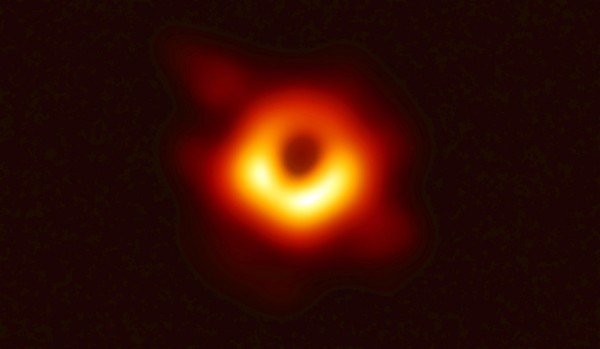《TAIPEI TIMES》 Taiwanese researchers help take first black hole image

Academia Sinica yesterday shared the first-ever image of a black hole taken by the Event Horizon Telescope project that connects eight telescopes across the world. Photo courtesy of Academia Sinica
By Lin Chia-nan / Staff reporter
Academia Sinica researchers participating in the Event Horizon Telescope (EHT) project yesterday evening shared the first image of a black hole, along with scientists in five other countries.
The accomplishment — an image of the black hole at the center of the Messier 87 (M87) galaxy — is one of the century’s most significant breakthroughs in physics and astronomy and Taiwan played a vital role, Academia Sinica President James Liao (廖俊智) told a news conference before the event in Taipei.
Local researchers were simultaneously sharing the discovery with researchers in Washington, Santiago, Brussels, Shanghai and Tokyo.
The image — unveiled at 9:07pm — showed a black center surrounded by a crescent of light, and the audience in Taipei expressed their amazement with a big round of applause.
The project researchers took the same image over the past seven days from their vantage point on Earth, the academy’s Institute of Astronomy and Astrophysics associate research fellow Keiichi Asada said, adding that the black hole in M87 is about 55 million light years away.
“Past observation has shown that there is a supermassive black hole at the center of M87, but previous technology could not create a clear image of it until today [Wednesday],” he said.
The achievement would open a new window on the study of gravitation and astronomy, he said.
The EHT is an international project working together to capture the image of a black hole by linking eight radio telescopes around the globe, creating a virtual Earth-sized telescope.
Academia Sinica members helped installed three of the telescopes, including the Atacama Large Millimeter/Submillimeter Array, the Submillimeter Array and the James Clerk Maxwell Telescope, the institution said.
Former institute director Paul Ho (賀曾樸) went to Denmark to take part in yesterday’s event, while institute researcher Chen Ming-tang (陳明堂) joined the one in Washington.
新聞來源:TAIPEI TIMES
%http://www.taipeitimes.com/

The Greenland Telescope, a radio telescope built by Academia Sinica’s Institute of Astronomy and Astrophysics and the Harvard-Smithsonian Center for Astrophysics, is shown in an undated photograph. Photo: Chien Hui-ju, Taipei Times / courtesy of Academia Sinica’s Institute of Astronomy and Astrophysic

















